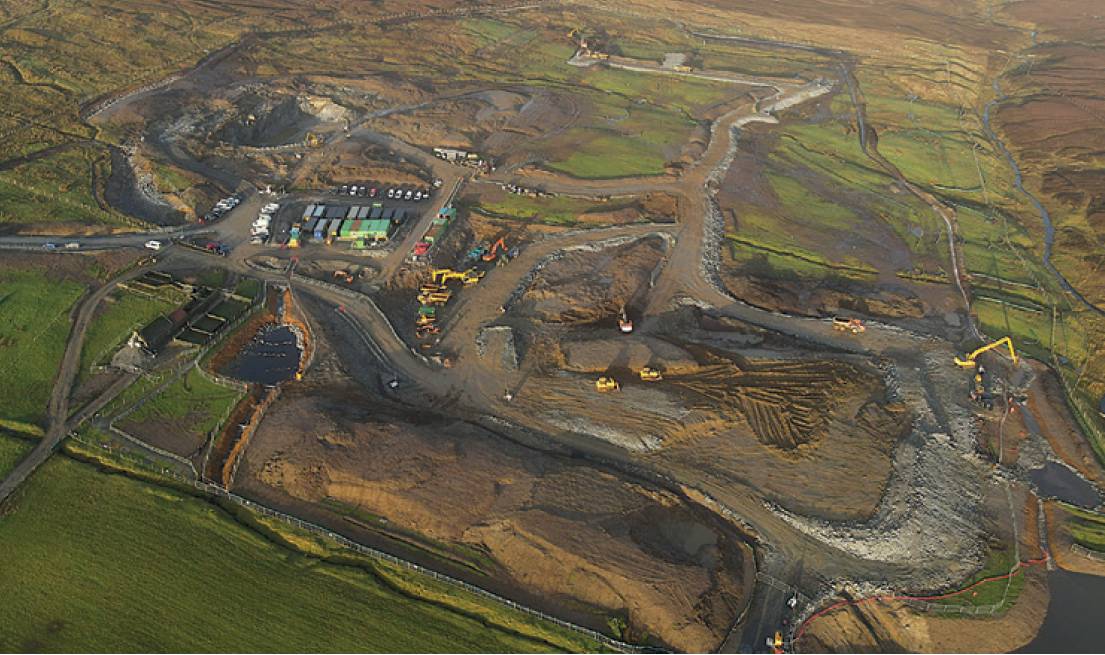New construction industry report reveals poor building material supply chains are the main barrier to achieving net zero

A new report, ‘Sustainable by design’, by engineering consultancy Patrick Parsons, based on research with 100 senior executives of UK construction firms, revealed that despite the majority (85%) believing the industry is doing enough to reach net zero by 2050, there are significant barriers to achieving this target.
Over two-thirds (68%) of respondents said that improvements to building material supply chains to reduce carbon would be critical to achieving net zero, followed by 63% who said that existing planning regulations need to change to support the sector if it is to hit this target.
Using alternative materials which have a lower carbon footprint is also a significant barrier to overcome for 62% of those questioned, followed by decarbonising existing buildings (59%) and the ability to collect data to measure carbon in buildings (48%).
When asked about the impact of the focus on climate change because of COP26, 86% said that they believe it will accelerate positive advances in sustainability in the sector during 2022.
Commenting on the findings of the report, Conor Murphy, senior partner in structural engineering at Patrick Parsons said: “The UK construction industry is committed to reaching net zero by 2050 and is confident that this target will be met.
However, this ambition is not without its challenges in terms of the materials used, the need for planning rules to change and the ability to decarbonise legacy buildings to improve their performance. Greater use of sustainable design and engineering in the planning of new developments, will support the pathway to net zero.”
The report can be found at https://www.patrickparsons.co.uk/wp-content/uploads/Sustainable-by-Design-Report-Web.pdf
Digital Twin Hub transfers from Centre for Digital Built Britain
From 1 April 2022, the DT Hub will transition from its current home at the Centre for Digital Built Britain to an Industry/Catapult partnership housed at the Connected Places Catapult. The transition will allow the community to accelerate its growth and address new and exciting project areas across the public and private sectors. It will also give it the opportunity to reach different people and industry sectors, scale innovation, expand resources and increase knowledge exchange.
CPC chief business officer, Paul Wilson, said: “Connected Places Catapult has been working with the Centre for Digital Built Britain since its inception and has been an enthusiastic member of the DT Hub since 2020, taking a leading role in the Climate Resilience Demonstrator (CReDo) collaboration, shown at COP 26. We are delighted to be inheriting the work of the Hub and look forward to growing the work of this vibrant and passionate community.”
The next phase of the hub will utilise the wider Catapult Network and its links to a range of innovators across industry and academia to build on the foundations laid by CDDB, growing the hub’s scale and impact.
Pix4D Germany wins a competitive tender for Deutsche Bahn to monitor railway infrastructure maintenance and construction in Germany
PIX4D has won a tender for Deutsche Bahn to provide solutions and services for upcoming railway infrastructure projects through the analysis and visualisation of drone images. The contract will be managed by DB Netz AG, the infrastructure operator of Deutsche Bahn AG using PIX4Dcloud, PIX4Dmapper, and PIX4Dmatic for processing and analysis of drone imagery in construction monitoring progress and quality assurance. It will be a building block for the digitalization of Deutsche Bahn’s infrastructure management.
Pix4D regional managing director, Henrik Battke, said: “Deutsche Bahn plays a leading role in the mobility shift towards CO2 neutrality and the protection of the environment for future generations. We are very pleased to be able to contribute to strengthening their railroad projects with our products and services.”
VolkerFitzpatrick appointed to deliver the redevelopment of Stanford-le-Hope railway station

VolkerFitzpatrick has been appointed to deliver the major redevelopment of Stanford-le-Hope railway station by Thurrock Council, with work due to start this summer.
The new station will feature step-free access from the street, wider platforms with covered waiting areas, increased cycle storage, and facilities for a coffee vendor. A footbridge with lifts will also be installed to help improve accessibility.
Mike Evans, operations director for VolkerFitzpatrick, said: “We are very pleased to be appointed to deliver the major redevelopment of Stanford-le-Hope railway station. We will work closely with the council and the local community to deliver this project. It will provide improved travel links that will create access to existing and new local job opportunities.”
BAM Nuttall consortium uses 5G network for the first time in UK construction

BAM Nuttall’s SSEN Transmission Shetland project which is a partnership with Attocore, and Building Research Establishment has begun using a private, stand-alone 5G network located on its remote site, Kergord in Shetland. It is used to support the connection of Shetland to the GB grid to help meet the islands’ future energy needs. The project’s team is designing and constructing the civils infrastructure for SSEN Transmission’s convertor station and substation, part of the Shetland HVDC link. When completed, this major link between Shetland and the Scottish mainland will feed renewable energy to the electricity grid, connecting to the GB grid for the first time.
BAM’s team is deploying numerous 5G supported solutions, including digital live cameras and drones; mixed-reality and virtual visualisation; artificial intelligence and Internet of Things sensors to monitor construction processes and measure progress.
The 5G network is funded by the Department for Digital, Culture, Media & Sport and aims to test the potential of new digital technology while demonstrating the benefits, that could be implemented across a range of industries.
The site area at Kergord spans 55,176m2 of challenging terrain; weather conditions are cold, wet and harsh; winter’s daylight hours are short. Clients and management teams also cannot easily visit the site and rely on reports, data, images and insights to track progress and make decisions, based in offices, 100s of miles from site. It is hoped technology, such as 5G and the capability it brings, will support more flexible working and increase the appeal of careers in construction to a wider diversity of people.
Jacobs and Palantir join forces for data solutions with near-term focus on the water sector
Jacobs Engineering Group Inc and Palantir Technologies Inc are collaborating to provide data and technology solutions for the infrastructure and national security markets. It will focus on the water sector in the near-term and involves launching a joint data analytics offering to support public and private sector clients in solving their most complex water infrastructure problems.
The water data analytics solution aggregates and analyses plant data to manage and optimise water and wastewater treatment plant operations and maintenance (O&M), aimed at reducing costs and improving plant performance. The partnership plans to expand and commercialise this innovative solution.
Together Jacobs and Palantir Foundry will draw on AI to optimise power, chemical usage and asset management. The derived analytics and insights are hoped to help increase plant performance, reduce lifecycle costs and secure plants from cyber threats – while supporting regulatory compliance and realization of ESG goals.
Fugro supports NIOT’s coastal community development plan with a large-scale bathymetry survey in India

India’s National Institute of Ocean Technology (NIOT) has commissioned Fugro to carry out a bathymetric survey along the Andhra Pradesh coast in southeastern India.
The survey will facilitate the Indian Government’s plans to develop and manage the exclusive economic zone to benefit the coastal community and protect marine living resources.
The data will also be used for a range of scientific research projects and coastal resilience studies like an assessment of coastal vulnerabilities and geohazard potential and ocean climate change.
The six-month project started in November 2021. Fugro will survey around 56,000-line kilometres of coastline in total, collecting bathymetric data in water depths between high tide line and 30m.
To gather insights about the seabed, Fugro’s specialist team is using a shallow-water boat equipped with a dual-frequency echosounder and a differential global positioning system for data acquisition.
In very shallow water – up to 5m – and the surf zone area, the Fugro team is going to use jet ski equipped with a differential global positioning system and a single beam echosounder.
Real-time kinematic positioning technology is being used for the topography survey. Mr. Bibhu Nayak, Fugro Country Manager in India, said: ”We are honoured to be part of this prestigious project, which will help strengthen our relationship with the NIOT.”
In brief:
- Havering London Borough Council has given Yotta a contract, worth just under £500,000, to supply it with services.to support the local authority’s highways, street lighting, street cleansing, parks, grounds maintenance and arboreal services.
- Data experts Murphy Geospatial have opened new offices in Birmingham at Trinity Point.
- LSBUD, the UK’s leading online safe digging resource, has switched its mapping system to Google Maps, helping it to benefit from detailed geospatial data to make searching for underground pipes and cables more accurately using satellite imagery.
- The infrastructure engineering software company, Bentley Systems is running a new student contest – Bentley Education’s Digital Twin Design Challenge to provide students with an opportunity to reimagine a real-world location with a structure designed using the video game Minecraft. Applications were submitted at the end of March with the finalists and winners announced 3 June.
- Fugro has signed a four-year global framework agreement with Heerema Marine Contractors for survey and positioning support services onboard Heerema’s heavy lift crane vessels.